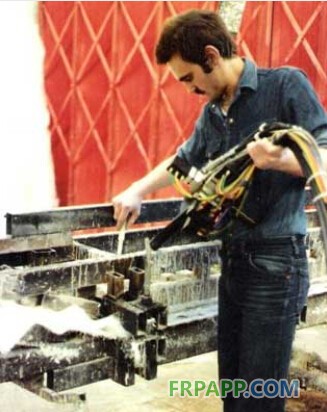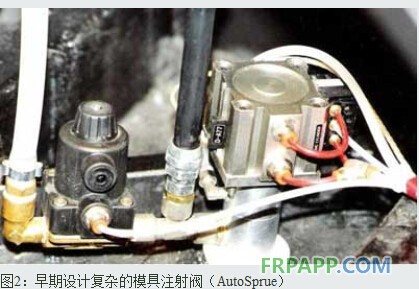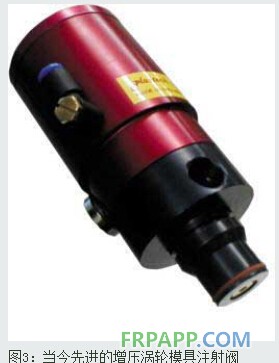RTM工艺的昨天,今天,和明天(上)
艾伦•哈珀(Alan Harper)先生供职于美国MVP有限公司,是树脂传递模塑(RTM)工艺领域的著名专家。本文是关于他对RTM工艺的起源,发展和应用,以及对后来轻型树脂传递模塑工艺(LRTM)的看法。
溯源RTM工艺
RTM工艺应用于复合材料行业已经有50多年了。尽管关于RTM最初应用的时间不是十分肯定,但是曾经有过关于英国飞机公司在50年代末开始应用RTM工艺的相关报道。据艾伦•哈珀介绍,自1973年他在英国艾尔斯伯里公司(Aylesbury)工作就开始接触RTM工艺。当时,他们从K&C模具公司买了一台1:1泵机,制造了第一套RTM模具。
回顾早期的模具工艺时,艾伦•哈珀用不堪回首形容。他说,利用当时的工艺在注射树脂时只能通过模具中央的一个孔注入,直到看到模具的四个角落都流过树脂时,人们才真正知道模具里是充满树脂的。因此你可以想像,经过反复几次生产后,模具的排气口会堆着越积越厚、早已变干的、如石笋状的树脂,常年累月下来必然造成巨大的浪费。
虽然后来人们确实采取了更好的设计方案,比如将模腔封死,然后在其周围铺设导流管,直接将树脂引流到外接到模具顶部的树脂收集器中。但这么做仍然不能避免严重的浪费,虽然模具是封闭的,模腔上的排气口仍然会释放些许苯乙烯废气,不仅需要定期清洗,而且每个周期后还需要重新更换。
直到80年代中后期,树脂注射工艺才开始显现出一些自动化的迹象。当时工艺的主要进展在于,操作人员不必携带着注射阀爬到模具上方,将注射头插入模具的注入口中,同时在整个注射过程中紧紧抓住注射头。待注射完成后将注射阀拔出,然后再迅速用塞子堵上模具的注入口,以防止树脂倒流。当谈到早期的RTM工艺,人们可能会笑,但是在那个年代,这样的工艺确实存在了许多年。

图1:在早期的RTM工艺过程中,操作人员需要手持注射阀,将其插入模具的注入口中。
而后,自动注射阀(AutoSprue)的发明又将RTM自动化的程度提高了一些,因为它代替人工将其插入模具的步骤。但是,对模腔中的树脂仍然使用的是旧方法进行管理。


随着RTM工艺的进一步发展,出现了更为先进的轻型树脂传递模塑工艺—LRTM,该工艺的首次应用是于1970年在德国。到1996年,法国Alwo公司主管让•雅克(Jean Jacques Sick)将LRTM工艺介绍给美国MVP公司闭模工艺专家查尔斯•图尔(Charles Tur)和法国国家成人职业协会(AFPA)复合材料讲师让•保罗(Jean Paul Galichet)。
当时,查尔斯•图尔还有另一个身份是比利时原料供应商Socomer的技术支持顾问,他一直致力于推进这项新工艺的进展,并对他们的客户进行相关培训。AFPA讲师让•保罗则将这门新工艺作为技术培训教案教授给学生。
与此同时,肖马拉复合材料公司(Chomarat Composites)也将混合毡—Rovicore推向市场,由于很好地迎合了低压注塑树脂渗透工艺的需求,一经上市就广受好评。到1998年,肖马拉公司开始奔走于世界各地,实地向客户展示如何运用LRTM新技术和模具制造Rovicore混合毡。
同年,查尔斯•图尔将LRTM介绍给Plastech公司(当时是艾伦•哈珀的公司),一经采纳当即看到了这项新工艺的真正优势和潜力。Plastech公司趁热打铁开发了一套RTM设备和模具配件(如密封件等),为其客户提供一个完整的LRTM工装包。Plastech还将LRTM技术作为在其全球RTM的培训课程的内容之一。
因此,LRTM工艺在90年代一经推出,立即给市场带来了一个更清洁的树脂注射系统。除了具有明显的成本和轻量优势,该工艺还降低接触液体树脂混合物的机会。LRTM的出现代表着整个闭模工艺发展的顶峰期,如今的用户在操作上已经变得越来越娴熟,能按需精准的建造模具。LRTM跟RTM很像,也是采取上下两片闭合模具,但是比传统RTM工艺的生产工作环境更清洁,而且浪费率更低。与RTM相反,LRTM工艺是让树脂先流经模具周边,最后多余的树脂从位于中央的出口流出。所有这些过程都在真空密封环境中进行,因此挥发性有机化合物排放量几乎为零。
英文原文:
RTM – past, present and future
Alan Harper
Alan Harper, closed mould specialist at MVP Ltd, is a well-know expert in resin transfer moulding (RTM) technology. Reinforced Plastics asked him for his views on the future of this processing technique.
Reinforced Plastics: When was the RTM process first used?
Alan Harper: To my knowledge RTM has been used for over 50 years. I became involved in RTM when working in Aylesbury, Bucks, UK, in 1973. We bought a 1:1 pump machine from K&C Mouldings and made our first RTM mould. Looking back, our mould technology was horrendous as when the resin was injected through a central mould hole, we only really knew it was full when resin poured from all four corners. Consequently you can imagine that after a few days of production we had huge wasteful stalagmites of harden resin on the floor growing daily towards the mould outlets. We did get better and designed the seals to run all around the mould cavity and installed pipes to direct the exiting resin into open cups balanced on the mould top. However, it was really wasteful, and although closed mould, the open vents still gave off styrene fumes and needed cleaning and renewing for each cycle.
I cannot be sure of the original use of RTM but have read that a UK aircraft company started to apply a form of RTM in the late '50s.
Reinforced Plastics: How did the process develop in terms of automation and control?
Alan Harper: It was not until the late mid '80s that a degree of automation in the actual injection of the resin started to appear. The main advance was to eliminate the need for the operator to climb onto the mould armed with an injection machine head, thrust it into the mould injection sprue port, and forcefully hold it down throughout the injection phase. After removing the nozzle a plug was quickly inserted manually to prevent resin back flowing. We laugh at this now but it really was like that for many years.
An AutoSprue was developed whereby the machine could simply be plugged into the mould injection port allowing hands free injection and flushing. However exiting resin still had to be managed by the old method.
Reinforced Plastics: When did Light RTM (LRTM) first appear?
Alan Harper: Light RTM technology was first developed in Germany in 1970. In 1996, Jean Jacques Sick, director of Alwo, France, introduced the Light RTM process to Charles Tur (currently closed mould specialist, MVP USA) and Jean Paul Galichet (composite teacher at AFPA, the French national association for adult vocational) through Alain Floret of Chomarat.
Charles, who was working as a technical support for Socomer, a raw material supplier in Belgium, continued to develop the process and conducted training to help their customer base to make their own moulds. Jean Paul Galichet, teacher at the AFPA (French government training centre) included the technology in their composite training programmes.
At the same time, Les Fils d'August Chomarat (Chomarat Composites) brought to the market their well known combination mat, Rovicore, which was ideally suited to the process by providing excellent permeability for the low pressure resin injection.
In 1998, after several demonstration days with AFPA Laval and Socomer, Chomarat engaged Charles Tur to use his experience with the process, to travel the globe to demonstrate Rovicore to their clients using the new LRTM techniques and moulds.
The same year, Charles Tur introduced the process to Plastech, the company I then owned, and we immediately saw the real advantages and potential of Light RTM. Plastech developed an RTM Machine and mould accessories, seals, etc. to provide a Light RTM package for their customer base. Plastech also combined Light RTM Technology to their existing worldwide RTM training courses.
Thus the introduction of the Light RTM process, in the '90s, immediately brought about a much cleaner resin injection system. Apart from its advantage of utilising much lower cost lightweight moulds, the process eliminated any need for the operator to be exposed to liquid resin mixes. This led to an enormous upsurge in a truly closed mould application in our industry which continues today as more users become proficient with the prerequisite to build their own accurate closed moulds. We are not speaking here about film infusion, which could be called closed mould, as it has only one engineered moulded surface and usually requires a new 'B' surface film tool for each production cycle.
Light RTM, like the original RTM method, produces two engineered moulded surfaces and far less wastage with considerably cleaner working environment over traditional RTM. Light RTM delivers the resin around the mould periphery and exits into a central catchpot. All this is under a modest vacuum level providing zero exposure to VOCs.

















 鲁ICP备2021047099号
鲁ICP备2021047099号